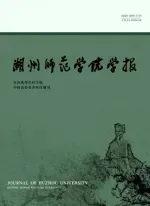英语中间功能动词理论在中学英语教学中的运用*
谢红芳
(湖州市第十一中学,浙江湖州 313000)
英语中间功能动词理论在中学英语教学中的运用*
谢红芳
(湖州市第十一中学,浙江湖州 313000)
英语中间功能动词理论是Quirk等人提出的一种新的英语语言理论,将这种新的语言理论运用于中学英语教学,对于解决中学英语教学中某些问题,提高中英语教学质量有一定的作用。
英语;中间功能动词;中学英语教学
一、中间功能动词理论简介
英国当代语言学家夸克等人在 A Com prehensive Grammar of the Eng lish L anguage中提出了中间功能动词(verbs of intermediate functions)理论[1]。他们把语法作用介于助动词和主要动词之间的动词分作以下四类中间功能动词。
(一)临界情态动词(marginalmodals)
夸克等人把dare,need,ought to,used to等动词称作临界情态动词,这类动词的语法作用相当于情态动动,它们像一般的情态动词一样与主要动词一起构成句子的谓语(相当于情态动词的dare和need通常只用于否定句和疑问句)。[2](P307-308)如She dare not go out alone at night./Need we hand in our homework tomorrow?
ought to和used to一样,都需要与主要动词一起构成句子的谓语动词。如We ought to finish our task as soon as possible./His father used to teach in a p rimary school in his hometow n.
(二)情态习语动词(modal idiom s)
夸克等人把had better,would rather,have got to等习语称作情态习语动词,这些习语的语法作用很像情态动词。除情态习语动词have got to,所列出的其它两个习语都没有人称、数和时间的变化,都需和主要动词在一起构成句子的谓语。如She had better quit school to look after her sick mother w hen she was fifteen years old./He w ould rather stay in school than go back home in the summer vacation.
夸克等人把have got to也归入情态习语动词,这是因为have got to虽然可有人称、数和时间的变化,但它的语法功能与had better,would rather基本相同。have got to也与主要动词在一起构成句子的谓语。如I have got to say goodbye to all of you right now.
(三)半助动词(semi-auxiliaries)
夸克等人在他们的两部语法著作 A Gramm ar of Contem porary Eng lish和A Com prehensive Gramm ar of the Eng lish Language中所说的半助动词其实并非一回事。在 A Gramm ar of Contem porary Eng lish[3]中,他们把 be about to,be going to,be sure to,be to,had better,have to,have got to,fail to,get to,tend to,be certain to,be likely to,happen to,seem to,turn out to等都称为半助动词。但在A Com prehensive Gramm ar of the Eng lish Language中却只把半助动词指称为包括由主要动词be和have引起的一组表示情态和时体意义的动词习语,如be able to,be about to,be ap t to,be bound to,bedue to,be going to,be likely to,bemeant to,be obliged to,be supposed to,be w illing to,have to等,如The child is able to dress herself now./The visiting team isbound to w in in thematch./Iw asabout to leave the cinema w hen it began to rain.
夸克等人把have to也称作半助动词,这是因为have to也必须和其它动词一起才能构成句子的谓语。如He had to face so many difficulties at that time.
但have to与be引起的半助动词不同,它也可以用在其它助动词或不定式之后,从这个意义上讲它是名副其实的半助动词。如I w ill have to m ake a decisive choice before Iam given a chance./We have had to finish the task ahead of schedule/She is going to have to give up.
(四)链接动词(catenative verbs)
夸克等人在 A Com prehensive Gramm ar of the Eng lish Language中最引人注目的是他们提出的链接动词理论,他们把happen,seem,get,fail等动词和不定式符号一起称作链接动词,把它们与动词不定式连用的这种结构叫做链接动词结构。
夸克等人认为seem,happen,appear此类动词和它们所接的动词不定式是一个不可分割的整体,充当句子的谓语。像 He happened to fall.这样的句子应分析为 He是主语,happened to fall是谓语。happened to fall是紧密相连、不可分割的链接动词结构。再如She appeared to know everything about it.这个句子的谓语动词是appeared to know,其宾语是everything,appeared to know是一个不可分割的链接动词结构。
二、中间功能动词理论在中学英语教学中的运用
在中学英语教学中,我们经常会发现一些关于谓语动词方面的问题,看似很简单,但老师在讲解时有时却很难作出令学生满意的解释。听老师讲解后,学生有时还是不明原由,教学效果可想而知。
在教学实践中我们发现,如能把中间功能动词理论运用于中学英语教学,很多类似的问题便会迎刃而解。这些问题主要可以归纳为以下几个方面。
(一)英语句子中谓语动词的分类
英语句子的谓语动词有各种类型,有的句子由主要动词作谓语,如 He studies hard./We d id some home work yesterday.有的由助动词与主要动词一起作谓语,如He hasstudied hard./They are having an English class.有的由情态动词与主要动词一起作为谓语,如He can translate the Chinese sentence into English./He m ust have learned the new s.
根据中间功能动词理论,还有一类英语句子的谓语动词是由中间功能动词与主要动词构成,即中间功能动词与主要动词一起构成句子的谓语动词,如 They ought to finish their home wo rk today.这一句子的谓语动词为中间功能动词中的临界情态动词ought to和主要动词finish构成。再如 The new s turned out to be true,该句中的谓语动词为中间功能动词中的链接动词turned out to+主要动词be构成。又如The train is due to arrive at two this afternoon,该句的谓语动词为中间功能动词中的半助动词is due to+主要动词arrive构成。
(二)英语中含中间功能动词句子的语法分析
把中间功能动词理论运用于中学英语教学,可以使本来难以解释的语言现象变得很容易解释,学生一听就懂,一看就明白,十分容易掌握。中间功能动词一般都是一个不可分割的整体,所以句子分析起来显得十分容易,如 He used to sw im in the river.如果学生知道used to是临界情态动词,它的作用相当于情态动词,他们就会很容易理解used to sw im这一谓语动词是由情态动词与主要动词构成的,既然used to相当于情态动词,它的形式当然是不变的。但是used to毕竟是临界情态动词,它与一般的情态动词有所区别,因此含used to的句子转换成否定和疑问结构时,操作词是used,如 He used not to sw im in the river./Used he to sw im in the river?
再如 You had better do it right away.按照中间功能动词理论,had better为情态习语动词,即had better是一种习惯用法,其作用相当于一个情态动词,该句的谓语动词理当是 had better do,it是该谓语动词的宾语。但had better毕竟不是一般的情态动词,所以用法与一般情态动词也有不同,因为含had better的句子转换成否定和疑问结构时,操作词是had,如You had better not do it right now./Had you better do it right now?
又如We are going to have ameeting.这是一个含半助动词的句子,根据Quirk等人中间功能动词理论,该句子的谓语动词是are going to have,该谓语动词的宾语为ameeting.这样的分析使学生对英语句子结构一目了然,记忆变得十分简单。此类句子变成否定句和疑问句时,其操作词是be,故原句的否定句和疑问句分别为We are not going to have a meeting./A re you going to have a meeting?
又如Tom seemed to know the answ er.按照中间功能动词理论,seemed to know是一个链接动词结构,在句子中作谓语,该谓语动词的宾语是the answer.将此类句子变成否定句和疑问句时,操作词为do,原句的否定式和疑问式分别为 Tom didn’t seem to know the answ er./Did Tom seem to know the answer?此类句子的被动结构是按主要动词进行操作的,故原句的被动结构应该是The answer seemed to be know n by Tom.这种分析十分科学,对英语教学十分有利,学生理解自然是不成问题的。
(三)中间功能动词同义词组用法区别
有些动词词组从意义上看好像没有什么差别,它们的用法似乎也没有什么区别,但如按中间功能动词的理论来分析,发现它们根本是两类不同性质的中间功能动词,它们之间用法上存在很大差别。在中学英语教学中,一般都把have to和 have got to等同起来,好像两者没有什么差别,但中间功能动词的理论告诉我们它们是有差别的,因为它们的动词类型完全不同,前者是半助动词,后者是情态习语动词。这就是说,虽然这两个动词词组意义上有相似之处,它们的用法是完全不同的。have to的用法和半助动词一致,所以它可用作谓语动词的一部分,如I have to leave now.have to前也可用其它助动词,如Iwill have to leave soon./I have had to do so.have to也可用在动词不定式之中,如I am going to have to leave soon.
have go t to是情态习语动词,它的作用与一般情态动词相似,所以它只能与主要动词构成句子的谓语,如我们可以说Ihave go t to leave now.或Ihad got to leave then.也可以用于否定式和疑问式Ihave not got to leave now./Have you got to leave now?//Ihad not got to leave then/Had you got to leave then?have got to,其前不能出现其它助动词,只能与主要动词一起构成句子的谓语。中间功能动词理论为我们在中学英语教学中讲清这两个词组区别提供了方便,学生也很容易理解。
综上所述,将Quirk等人的中间功能动词理论运用于中学英语教学,对于改进中学英语教学,提高中学英语教学质量确实有一定作用,值得引起我们重视。
[1]Quirk R.A Com prehensive Grammar of the Eng lish Language[M].London:Longman Group Limited,1997.
[2]章振邦.新编英语语法教程[M].上海:上海外语教育出版社,2005.
[3]Quirk R.A Grammar of Contem porary English[M].London:Longman Group Limited,1972.
The Application of the Theory of Verbs of Intermediate Function in M iddle-School English Teaching
X IE Hong-fang
(Huzhou No.Eleven M iddle School,Huzhou 313000,China)
The theory of verbs of intermediate function put forward by Quirk et al is a new linguistic theory in English,the app lication of w hich can p lay a certain role in helping solve some p roblem s inmiddle-school English teaching and imp roving middle-school English teaching.
English;verbs of intermediate function;middle-school English teaching
H319.3
A
1009-1734(2010)05-0138-03
2010-05-03
谢红芳,中教一级,从事中学英语教学研究。
[责任编辑 陈义报]

